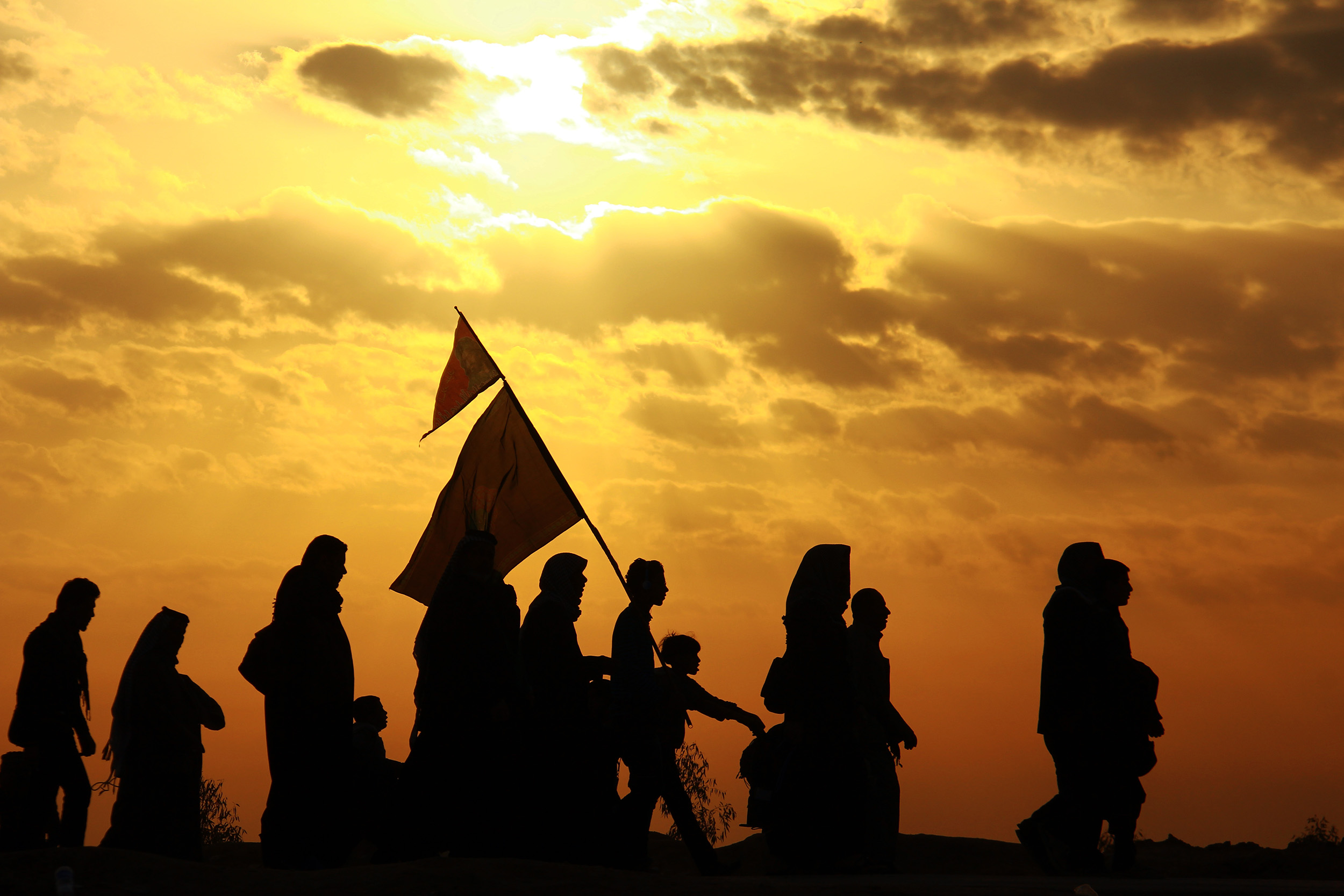

Imam Ali (AS), the Commander of the Faithful
“Among the faithful are men who fulfill what they have pledged to Allah. Of them are some who have fulfilled their pledge, and of them are some who still wait, and they have not changed in the least” (33:23). On the 21st night of the holy month of Ramadan, the followers of Prophet Muhammad (PBUH&HP) and his successors experienced another great suffering after the prophet’s death. When the first Imam, Imam Ali ibn Abi Talib (AS) was martyred after he received the fatal injury over his head on the 19th of Ramadan.
But what was the reason behind deep oppositions against this pious and god-fearing man and the true successor of Prophet Muhammad (PBUH&HP)? Why would anyone intentionally decide to deprive him of his rights, spread lies against him, harm him, or take his life? Who was Ali ibn Abi Talib (AS)?
He was the first male person who heard our dear Prophet’s recitation of the revealed words of Allah on the 27th of Rajab, known as Mab’ath Day, and accepted him as the Almighty’s true last and greatest messenger wholeheartedly when he was only ten years old.
When the Prophet (PBUH&HP) gathered the Quraish tribe to announce his message of monotheism publicly, it was the young Ali (AS) who openly testified to the Oneness of God and the mission of Prophet Muhammad (PBUH&HP), when all the others remained silent and did nothing but giving blank looks. This sowed the first seeds of evil sentiments in the hearts of polytheist Arabs against the Commander of the Faithful. They would hatch any plot against the Holy Prophet (PBUH&HP) including the bid to assassinate him in Mecca.
Again, there was no one but Ali (AS) who saved his leader’s life by sleeping on his bed that very night so that the ones who had surrounded them would think that Prophet Muhammad (PBUH&HP) was lying in bed; as a result, the Prophet safely left Mecca. The Arab infidels also imposed several wars upon the Prophet at Badr, Uhud, Khandaq, Hunayn, and Khaybar. Thanks to the flashing blade of Imam Ali (AS), the Zu’l-Feqar, all these plots were aborted as well.
Not only did Imam Ali (AS) excel on the battlefields, but he also displayed other merits, such as knowledge, prudence, wisdom, piety, courage, and generosity. It was Ali (AS) who gave his ring as alms (Zakat) while in genuflection during the ritual prayer, which brought divine approval for the Imam as the 55th verse of Maedah chapter bears testimony:
“Your guardian is only Allah, His Apostle, and the faithful who maintain the prayer and give the zakat while bowing down.” (5:55)
The feelings of hostility towards the Most Virtuous Believer, Ali (AS), reached its climax among his enemies when on God’s express command Prophet Muhammad (PBUH&HP) publicly proclaimed Imam Ali (AS) as his successor at the historic assembly of Ghadir Khum on 18th Dhu al-Hijjah 10 AH.
“Today I have perfected your religion for you, and I have completed My blessing upon you, and I have approved Islam as your religion.” (5:3)
But Imam Ali (AS) was deprived of his true right of political leadership for a quarter of a century. In 35 AH, when Ali (AS) took up the political rule at the desperate Muslims’ insistence, he only abode by the Holy Quran and the Prophet’s teachings (Sunnah). However, for his very insistence on spreading justice and observing the true rights of each individual, his enemies, the seditions, the pledge-breakers, and the Renegades (Khawarij) declared hostility and war against him, which later on became known as The Battle of Jamal.
The renegades, just as ISIS in our time, were appeared to be devoted to God to the extent that from their long and incessant prostrations their foreheads were covered with calluses, while they were ignorant of Islam’s truth and were unable to distinguish between right and wrong.
Finally, the Supreme emblem of Justice was struck on the head on the 19th of Ramadan, the first of the three grand nights of Qadr (Laylat al-Qadr) in prayer and worship, in the Grand Mosque of Kufa by the poisoned sword of the renegade, Ibn Muljam al-Moradi.
Despite the severity of the wound, the first phrase that came to the lips of the Commander of the Faithful was: “Fuzto wa Rabb-il-Kaaba.” It means by the Lord of the Kaaba I have succeeded.
So, the pledge made to God by Imam Ali (AS) decades ago was fulfilled in the early hours of the 21st of Ramadan as his soul flew towards the ethereal heavens. After he embraced martyrdom, the poor and homeless never again saw the man who in the middle of the night, bring food and water for them.
The orphans of Kufa could not find anyone who would kindly listen to and sympathize with their pain. When he left this earthly life behind, no ruler ever came to power who could surpass him in justice and in observing the rights of all the people, rich or poor, equally. No man ever set foot on earth who, like him, was endowed with the infinite and divine knowledge of Prophet Muhammad (PBUH).
Prophet once said “I am the city of knowledge and Ali (AS) is the gate to this city. Anyone who is willing to enter this city must first pass the gate.” Such was the man whom we lost on the second night of Qadr.
Reference:
Share This Article

Narrations on Karbala and the pilgrimage of Imam Hussain (as) part2
Hadith 21: The Condition of Honor
Imam Sadiq (as) said: Whoever wants to be in the neighborhood of the Prophet (pbuh&HP) and next to Ali (AS) and Fatima (AS) should not leave the pilgrimage of Imam Hussain (AS).
Wasa'il al-Shi'ah, vol. 10, p. 331, p. 39
Hadith 22: Pilgrimage, Divine Duty
Imam Sadiq (as) said: If one of you observes the Ihram of Hajj for the entire of his life but does not visit Imam Hussain (as), he has left the right of the Messenger of Allah (PBUH&HP) because the right of Hussain (as) is a divine duty and obligatory for every Muslim.
Wasa'il al-Shi'ah, vol. 10, p. 333
Hadith 23: Karbala, the Kaaba of Perfection
Imam Sadiq (as) said: Whoever does not visit the grave of Imam Hussain (as) until he dies, his faith will be incomplete and his religion will be incomplete, and when he goes to heaven, he will be lower than the believers there.
Wasa'il al-Shi'ah, vol. 10, p. .335
Hadith 24: From Pilgrimage to Martyrdom
Imam Sadiq (as) said: Do not leave the pilgrimage of Imam Hussain (as) and recommend it to your friends and companions as well! May Allah prolong your life, increase your sustenance, and may Allah bless you alive and you will not die except as a martyr.
Wasa'il al-Shi'ah vol. 10, p. 335
Hadith 25: The Hadith of Love
It was narrated from Imam Sadiq (as) that he said: Whoever Allah wants good, will put the love of Hussain (AS) and his pilgrimage in his heart, and whoever Allah wants bad, will have him hate Hussain (AS) and anxious with his pilgrimage.
Wasa'il al-Shi'ah vol. 10, p. 388, Sea of Lights, vol. 98, p. 76
Hadith 26: A Sign of Being a Shiite
Imam Sadiq (as) said: Whoever does not visit the grave of Imam Hussain and dies as our Shiite and dies, is not our Shiite, and even if he is from the people of Paradise, he is the guest of the people of Paradise.
Kamel Al-Ziyarat, p. 193, Bihar Al-Anwar, vol. 98, p.4
Hadith 27: Ascension Platform
Imam Sadiq (as) said: Whoever visits the grave of Hussain (as) and has knowledge of the right of that Imam, Allah Almighty will register him in the highest rank.
Man la yahzurul Faqih, vol. 2, p.581
Hadith 28: The School of Knowledge
Imam Musa Kadhim (as) said: The least reward that is given to the pilgrim of Imam Hussain (as) on the banks of the Euphrates is that all his sins, before and after, are forgiven. Provided that he knows the right, honor and guardianship of that Imam.
Mustadrak al-Wasa'il, vol. 10, p. 236, quoting Kamil al-Ziyarat, p. 138
Hadith 29: Like the Pilgrimage of Allah
Imam Reza (as) said: Whoever visits the grave of Imam Hussain (as) on the banks of the Euphrates is like the one who has visited Allah.
Mustadrak al-Wasa'il, vol. 10, p. 250, quoting in full
Chapter Three: Ashura and Arbaeen
Hadith 30: Pilgrimage at Ashura
Imam Sadiq (as) said: Whoever visits Imam Hussain (as) on the day of Ashura, heaven will be obligatory for him.
Iqbal al-A'mal, p. 568
Hadith 31: Above Prosperity
Imam Sadiq (as) said: Whoever wakes up on the night of Ashura next to the shrine of Imam Hussain (as), on the Day of Judgment he will rush to Allah stained in his blood, like someone who was killed in Karbala next to Imam Hussain (as).
Wasaelu shiah, vol. 10, p.372
Hadith 32: Signs of Faith
Imam Hassan Askari (as) said: The signs of a believer are five:
1 Fifty prayers
2 Arbaeen pilgrimage
3 Ring in the right hand
4 Prostrating on the ground
5 Saying loudly the name of Allah, (Bismillah Rahman Rahim)
Wasaelu shia, vol. 10, p. 373, and also Al-Tahdhib, vol. 6, p. 52
Chapter Four: Torbat and Tasbih of Love
Hadith 33: His Porch
The Prophet of Islam (PBUH&HP) said: Know that the answer to prayer is under the dome of his shrine and healing is in his soil, and the Imams (as) are of his children.
Mustadrak al-Wasa'il, vol. 10, p.335
Hadith 34: Soil and Training
Imam Sadiq (as) said: Take your children with the soil of Hussain (as) (Karbala) because the soil of Karbala insures your children.
Wasaelu Shiah, vol. 10, p.410
Hadith 35: The Greatest Medicine
Imam Sadiq (as) said: The cure for any pain is in the soil (torbat) of Hussain (as) and it is the greatest medicine. Kamil Al-Ziyarat, p. 275 and Wasa'il al-Shi'ah, vol. 10, p. 410
Hadith 36: Torbat (soil of Karbala) and seven hijabs
Imam Sadiq (as) said: Prostration on the soil of Hussain (as) tears the seven veils.
Mesbah al-Muttahid, p. 511, and Bihar al-Anwar, vol. 98, p. 135
Hadith 37: Prostration on the Soil of Love
Imam Sadiq (as) did not prostrate on the ground except on the soil of Hussain (as) and he did this in violence for the sake of Allah.
Wasailu shiah vol. 3, p.608
Hadith 38: Rosary with the Soil of Karbala
Imam Sadiq (as) said: Prostration on the soil of Karbala can light up to the seventh earth, and whoever has a rosary from the soil of the shrine of Hussain (as) with him, is a truthful person, even if he says nothing.
Man la yahzurulFaqih vol 1 p 268
Hadith 39: Healing Soil
Imam Kadhim (as) while narrating a hadith announcing his death, said: do not take anything from the soil of my grave to seek blessings, because it is forbidden for us to eat any soil except the soil of my grandfather Hussain (as), Allah Almighty has healed only the soil of Karbala for the Shiites and our friends.
Jami ahadith, vol. 12, p.533
Hadith 40: One of the Four Needs
Imam Musa ibn Ja'far (as) said: Our needs are four things:
1. Prayer mat on which prayers are offered.
2. Rings on the finger
3. Toothbrush with which to brush teeth
4. A rosary from the shrine of Imam Hussain (as) Tahdhib al-Ahkam, vol. 6, p. 75
Read More

Why is Drinking Alcohol Forbidden in Islam?
Today, more than anything, people are concerned about what they eat and drink. And that is for a good reason; for you to live a fuller life, you need a healthy body alongside a healthy mind. And you can function better in the society as well. So a useful and practical food diet is the one which can guarantee both of these factors.
This is only one reason why Islam has forbidden drinking alcohol. Let’s regard this matter in depth.
1. What does Quran say about Alcohol?
There are many verses in the Quran that directly or indirectly prohibit Muslims from drinking alcohol and emphasize the disadvantages of this action, one of which is as follows:
“O you who have faith! Indeed wine, gambling, idols, and the divining arrows are abominations of Satan’s doing, so avoid them, so that you may be felicitous. Indeed Satan seeks to cast enmity and hatred among you through wine and gambling and to hinder you from the remembrance of Allah and from prayer. Will you, then, relinquish?” (5:90-91)
The above verse reveals two destructive effects of drinking alcohol. They are threatening to the society as well as each individual.
Your Society is in Danger
Morally speaking, it is evident in many instances that drinking alcohol lowers the brain’s function and makes it unclear [1] & [2]. Thus the person would lose his/her control over his/her actions and could exhibit any behavior out of the moral boundaries. A simple misunderstanding, then, may cause a serious clash between the members of the society, since they are not in their right mind and cannot reason well.
Moreover, many car accidents in the society are caused by the drivers who have been under the influence of alcohol. According to a study:
Consuming alcohol before driving greatly increases the risk of car accidents, highway injuries, and vehicular deaths. The higher the amount of consumed alcohol, the more likely to be involved in an accident. When alcohol is consumed, many of the skills that safe driving requires – such as judgment, concentration, comprehension, coordination, visual acuity, and reaction time – become impaired [3].
Your Faith is in Danger
The one who consumes alcohol will be occupied with such jubilant feeling caused by alcohol that he/she will forget his/her duty toward Allah. One of the essential teachings of Islam is that a Muslim should be able to feel Allah in his/her heart in every breath and His presence in all his/her actions [i].
Through drinking alcohol, even in small quantities, your mind loses its sharpness and focus to fully attend to your necessary actions as a Muslim, e.g., daily prayer (Salat).
You Choose not to Choose by Drinking Alcohol!
We are born to be free, to choose and to decide for ourselves. That is why we are endowed with the power of reason. The one who drinks alcohol voluntarily drops the guard of his/her reasoning down. He/she deprives him/herself of the ability to choose the right manners and have control over his/her life. With an unclear mind no one can practice his right to choose, thus is not free!
Your Loss Is More than Your Profit
The holy Quran says: “They ask you concerning wine and gambling. Say, ‘There is a great sin in both of them and some profits for the people, but their sinfulness outweighs their profit.’…” (2:219).
Almost in all our decisions, we are careful to choose the way that is more profitable for ourselves, be it financially, physically or morally. According to the Quran and many scientific studies, drinking alcohol brings more negative effects than positive. Thus its loss is way more than its profit. So it would be more rational to avoid drinking alcohol than to bear its negative consequences.
2. What Do Scientists Say about Alcohol?
On the other hand, a lot of research conducted by scientists from all over the world shows that alcohol consumption has many detrimental effects on human health [4], [5] & [6].
Brain and nervous system is the first part of the body that would be seriously harmed by drinking alcohol. According to research, “Heavy drinking can cause a form of nerve damage known as alcoholic neuropathy, which can produce a painful pins-and-needles feeling or numbness in the extremities as well as muscle weakness, incontinence, constipation, erectile dysfunction, and other problems” [1]. Moreover, some scientists believe that one of the leading causes of depression is alcohol consumption.
According to a study:
1. “If you drink regularly, you increase your risk of developing pancreatitis.
2. Over the long term, drinking alcohol increases your risk of serious illnesses, such as mouth, throat and breast cancer
3. One of the most significant of these was the 2007 European Prospective Investigation into Cancer and Nutrition (EPIC) study which established a clear link between excessive alcohol intake and bowel cancer.
4. Drinking alcohol can contribute to the conditions that cause diabetes.
5. Our brains rely on a delicate balance of chemicals and processes. Alcohol is a depressant, which means it can disrupt that balance, affecting our thoughts, feelings, and actions – and sometimes our long-term mental health.
6. Drinking alcohol at any stage during pregnancy can cause harm to your baby and the more you drink, the greater the risk. This is why the UK Chief Medical Officers' (CMO) alcohol unit guideline advice to pregnant women is that the safest approach is to not drink alcohol at all during pregnancy.
7. Drinking alcohol can increase your risk of developing liver disease and cause irreparable damage to this significant part of your body. In fact, alcohol is a major cause of the 25% increase in deaths from liver disease in England over the last decade (from 9,231 in 2001 to 11,575 in 2009)” [4] & [7]
I am A Muslim then…
Finally, you may say that all these health effects of Alcohol are probable. Or a day will come that scientists will find a way to drop these adverse effects. If we have accepted to be Muslim, to surrender to the will of Allah, and believe that He desires the best for us in this world, then we would easily trust Allah’s commands.
So, trust Him in eliminating what He calls disadvantageous for you. And keep in mind that there is always a rationale behind whatever Allah commands; whether this logic has been revealed to us or not.
Notes:
[i] Quran (33:41-42)
References:
Read More

